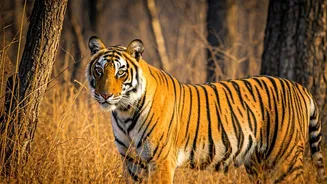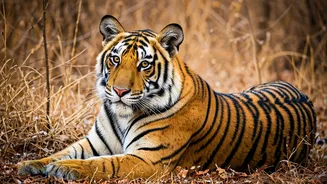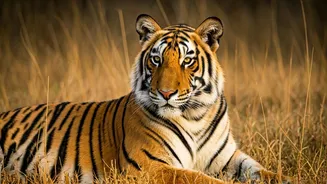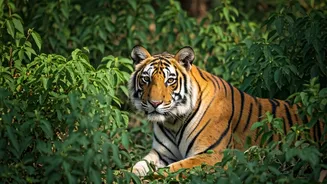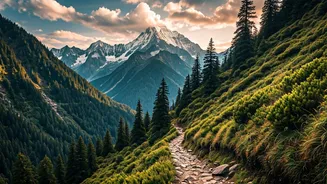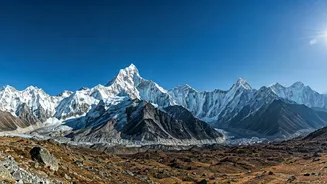Winter Tiger Trails
Winter is a prime time for tiger sightings in India. The cooler temperatures and drier conditions encourage tigers to be more active and visible. The reduced
foliage also makes it easier to spot them. Several national parks and tiger reserves across the country offer excellent opportunities for wildlife enthusiasts. Selecting the right location is key to a memorable experience, considering factors such as accessibility, terrain, and the specific tiger population. Understanding the best time to visit each location, typically from November to May, and booking safaris in advance can greatly enhance your chances of seeing these magnificent animals. Remember to respect wildlife and their habitats, by following the guidelines of each park.
Periyar Tiger Reserve
Nestled in the Western Ghats of Kerala, Periyar Tiger Reserve offers a unique experience. Apart from tigers, this reserve is home to elephants, various bird species, and diverse flora. Boating on Periyar Lake provides excellent opportunities for wildlife viewing, with tigers often seen near the water's edge. The lush, evergreen forests of Periyar contrast beautifully with the serene lake. Guided treks and jeep safaris can further enhance the experience, allowing you to explore the park's interior. December to May is the ideal time to visit, when the weather is pleasant and the chances of spotting wildlife are higher. Accommodation options range from eco-lodges to luxury resorts, ensuring a comfortable stay.
Bandhavgarh National Park
Bandhavgarh National Park in Madhya Pradesh is renowned for its high tiger density. The park features a unique landscape with ancient forts, caves, and grasslands. The rugged terrain and diverse ecosystems provide a perfect habitat for tigers. Early morning and late afternoon safaris often yield the best sightings. Bandhavgarh is also home to a significant population of leopards, deer, and other wildlife. The park's historic significance, coupled with its natural beauty, creates an immersive experience for visitors. Planning your safari in advance and hiring a knowledgeable guide will increase your chances of spotting a tiger in Bandhavgarh.
Ranthambore National Park
Ranthambore National Park in Rajasthan offers a glimpse into the life of tigers amidst historical ruins. The park is characterized by its dry deciduous forests, rocky terrains, and the presence of the Ranthambore Fort. Tigers are regularly sighted here, often against the backdrop of the fort. Safaris in open-top jeeps are popular, giving visitors an unobstructed view of the animals and landscape. Ranthambore is also home to a wide array of bird species and other wildlife, providing a complete wildlife experience. Visiting during the winter months when the weather is cooler and the wildlife is more active, can make your trip even more successful.
Jim Corbett National Park
Jim Corbett National Park in Uttarakhand, India's oldest national park, is a haven for tigers. The park boasts a diverse ecosystem, including grasslands, riverine belts, and dense forests. Tigers are frequently sighted here. The park offers jeep safaris and elephant rides. Corbett's lush greenery and varied topography provide a stunning backdrop for wildlife sightings. The presence of the Ramganga River adds to the park's biodiversity. Booking accommodation within the park or nearby resorts ensures you are close to the action. Keep an eye out for other wildlife like elephants, deer, and a multitude of bird species.
Tadoba Andhari Tiger Reserve
Tadoba Andhari Tiger Reserve in Maharashtra is known for its high tiger population and frequent sightings. The park is covered in dense forests, providing excellent habitat for tigers. Open-top jeep safaris are the primary mode of exploring the reserve, giving visitors a great chance to witness tigers and other wildlife. The park is a great spot to see other wildlife species. The best time to visit Tadoba is during the winter season when the weather is favourable and wildlife is more active. Numerous resorts and hotels are situated around the park. Advance booking for both safaris and accommodations is highly recommended.
Kaziranga National Park
Kaziranga National Park in Assam, a UNESCO World Heritage Site, is famous for its one-horned rhinoceroses and also boasts a significant tiger population. The park's grasslands, wetlands, and forests create a diverse ecosystem. Kaziranga's unique landscape and biodiversity make it a prime location for wildlife photography. Elephant safaris offer a unique perspective for wildlife viewing. The park’s commitment to conservation adds to its appeal. Visit during the winter months when weather is optimal and the park is fully open for safaris. Consider hiring a local guide to gain valuable insights into the park's ecology.
Kanha National Park
Kanha National Park in Madhya Pradesh is a beautiful tiger reserve with a rich biodiversity. It’s the inspiration behind Rudyard Kipling's 'The Jungle Book'. The park's sal and bamboo forests, grasslands, and plateaus provide a diverse habitat. Kanha is home to various species of deer, birds, and other animals, creating a rich wildlife experience. Jeep safaris provide good viewing opportunities, and the park’s natural beauty adds to the experience. For the best viewing experience, the park is open during the winter months when the weather is most suitable.
Pench National Park
Pench National Park, situated in Madhya Pradesh and Maharashtra, is divided into two parts, offering an excellent tiger habitat. The park’s mixed deciduous forests and riverine environments support a rich ecosystem. Pench is known for its tiger sightings and diverse wildlife. Jeep safaris are the best way to explore the park and spot wildlife, including various bird species. The park's beautiful landscape and conservation efforts enhance its appeal. Plan your visit during the winter months for the best wildlife viewing experience.
Sundarbans National Park
Sundarbans National Park, a UNESCO World Heritage site, is known for its unique mangrove forests and the Bengal tiger. The park's dense mangrove forest and tidal waters create a unique ecosystem. Wildlife viewing is primarily done through boat safaris, offering a chance to spot tigers. This region requires boat safaris for wildlife viewing. The park's unique landscape is unlike other tiger reserves. It is home to many bird species. The best time to visit is during the winter months when the weather is favorable and the tigers are active. Permits and guided tours are essential to explore this protected area.
